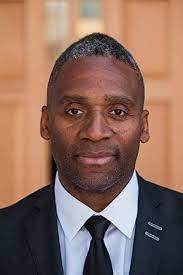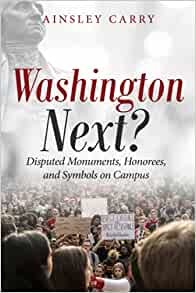As colleges and universities move to promote diversity, equity, and inclusion, their campuses remain studded with tributes to a more racist past. Memorials and monuments celebrate slaveholders and segregationists, and dormitories and dining halls are named for colonizers and Confederates.
Student protests are growing, with mixed results. Although the University of North Carolina (UNC) removed its “Silent Sam” Confederate memorial after it was toppled by protestors, Georgia’s public university system recently announced that it wouldn’t rename any of 75 buildings associated with slavery, segregation, or the harm done to American Indians.  Dr. Ainsley Carry
Dr. Ainsley Carry
Dr. Ainsley Carry has been analyzing these issues for several years, and he offered his observations Wednesday in a Zoom discussion entitled “Washington Next? Disputed Monuments, Honorees, and Symbols on Campus.” The event was sponsored by the Dr. Melvin C. Terrell Education Foundation, which provides scholarships and professional development support for graduate students who plan to pursue careers in higher education. The discussion’s title (which it shares with Carry's recent book) comes from President Donald J. Trump’s controversial rhetorical question after counter-protesters supporting the removal of a statue of Robert E. Lee were attacked in Charlottesville, Virginia in 2017. Would statues of America’s first president—a slaveholder—be the next to come under fire? It was, as the moderator, Rev. Dr. Jamie Washington, a past president of the American College Personnel Association, put it, “not a conversation for the faint of heart.”
Carry takes the concerns of protesters far more seriously than did the former president. His research on the topic began when, as vice president for student affairs at the University of Southern California (USC), students met with him to request the removal of the name of Rufus B. von KleinSmid, USC’s fifth president and a leading eugenicist, from a campus building.
“I didn’t completely understand the historical context of eugenics and how it changed our world,” said Carry. “So, I wasn’t in a position to be supportive. I wasn’t in a position to say, ‘Oh, let’s look into that. Let’s bring this to the senior administration.’” KleinSmid’s name was eventually removed in 2020.
After that, Carry sought to support students better.
“Universities are wounded spaces,” he said. “We have students coming from all walks of life. And before they landed on our campus, many of them have been through a lot of trauma. And then that trauma is confronted by a memorial in a residence hall or a building name. We have to get to the point where, if we’re going to diversify our universities, we have to walk around the campus saying, ‘What does it feel like to be a young Black male on this campus? What does it feel like to live in a residence hall, create community under the banner of a Confederate leader?’”
For his book, Carry studied 25 campus memorial disputes between 2015 and 2020. He charted their similarities and differences and realized that university administrators tended to view the issue using one of four frameworks: the question of what the honoree’s principal legacy was; the question of what is worthy of being preserved; the question of how the memorial impacts feelings of equity and inclusion for all; and the question of whether an honoree should be judged by the moral standards of the past or the present.
Carry believes that each of these lenses is important, but he feels that using just one is not enough. He argues that colleges and universities need to use multi-frame thinking to address these issues.
“My hope is that universities will take these decisions as more complex and more nuanced and dive into all the angles,” he said.
Disputes about memorials are often viewed as binary: either nothing will change, or the memorial will be removed and presumably, destroyed. Carry hopes that considering the different dimensions of the issue will make a wider array of solutions that can improve student comfort and health apparent. These potential solutions include moving disputed monuments to history museums, adding contextual information to a monument to give a fuller picture of the honoree, or adding additional monuments to honor figures such as slaves who built campus buildings.
However, Carry does not prescribe any specific outcomes for colleges and universities.
“I didn’t want to sit at University of British Columbia and tell the University of South Carolina what they should do because I’m so removed from that community,” he said. “It’s really dependent on what the community believes.”
As an example, he pointed out differences in how Duke University, the University of Texas, and Washington and Lee University handled controversy over campus remembrances of Robert E. Lee. Duke and the University of Texas removed statues of Lee, while Washington and Lee, of which Lee was president and where he and his family are buried, changed various campus references to the Confederate general, but decided not to change their school’s name.
“I agree with Duke and the University of Texas, [but] I hesitate, as an outsider to the Washington and Lee community to impose my values on their decision-making process. [It’s a] completely different culture, different issues on their campus, different feelings about Robert E. Lee. His name is embedded in the university; he isn't just a statue,” said Carry.
Though simple, universal answers may not exist, Carry thinks that, for university administrators, the questions may be unavoidable.
“My objective is to help you get ready and perhaps even encourage you to be proactive,” he said. “If you haven’t had a dispute on your campus yet—you will.”















